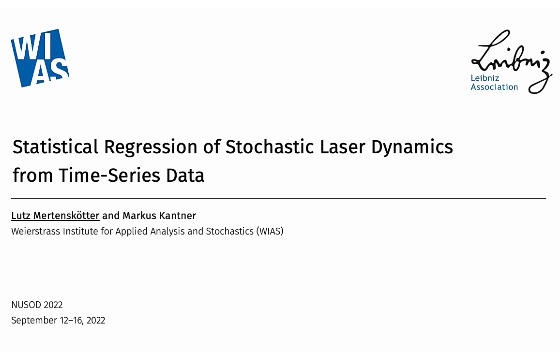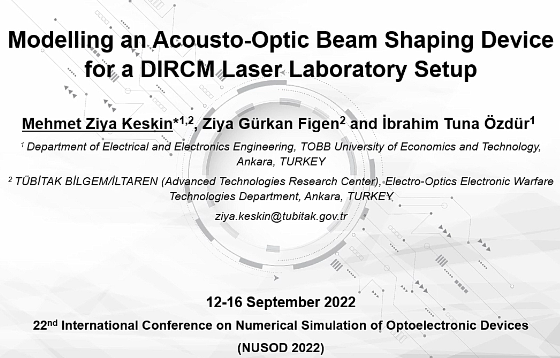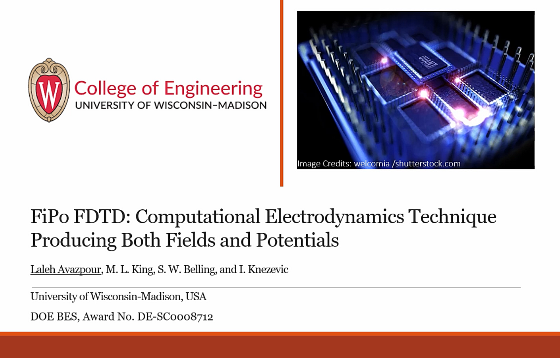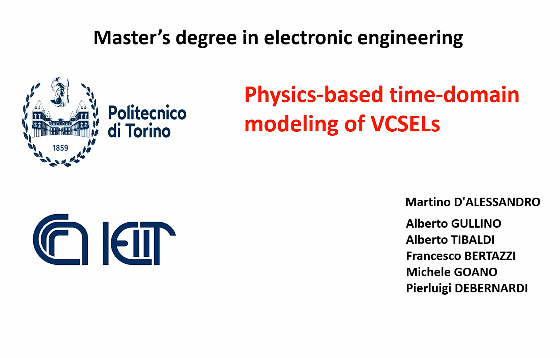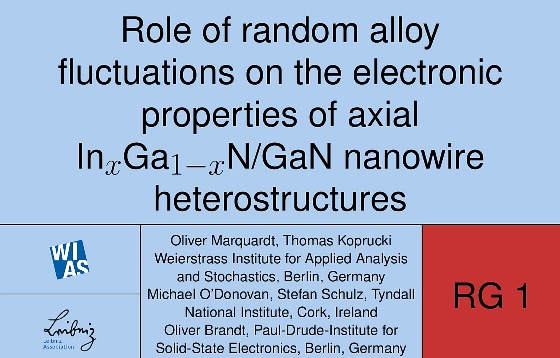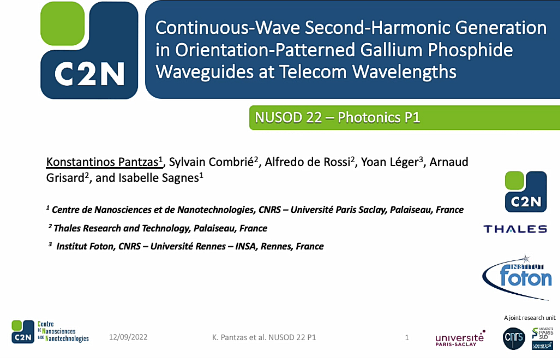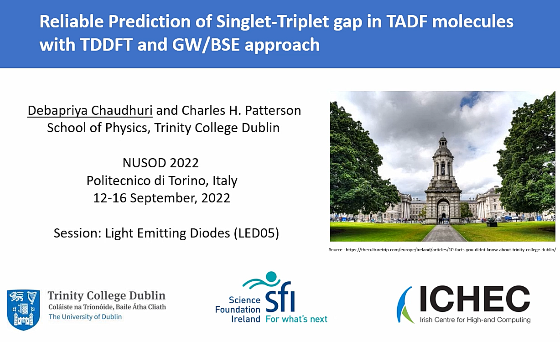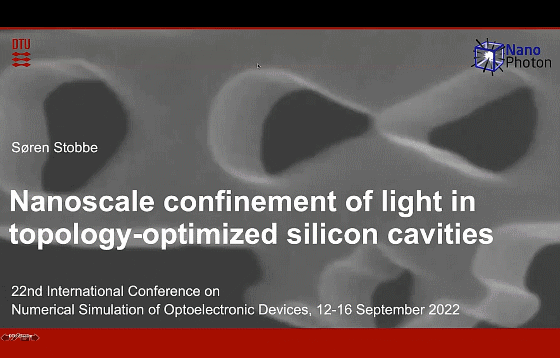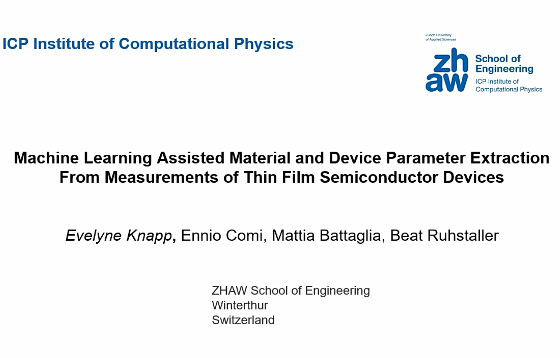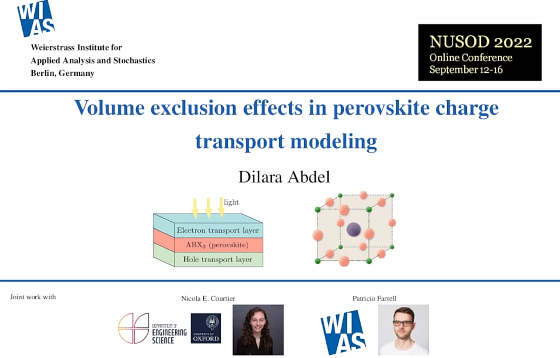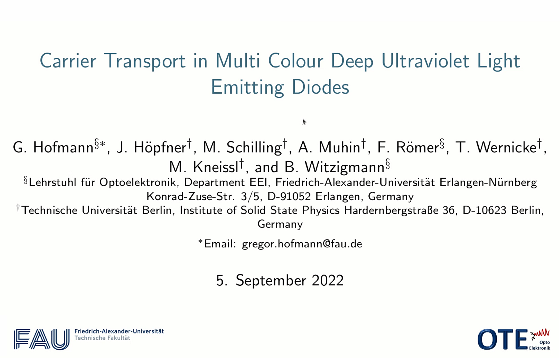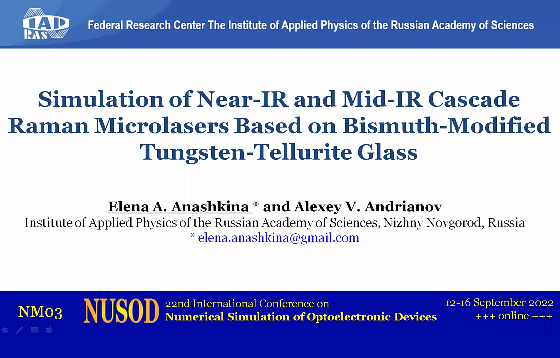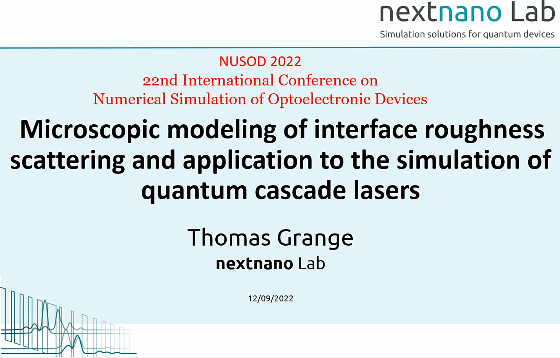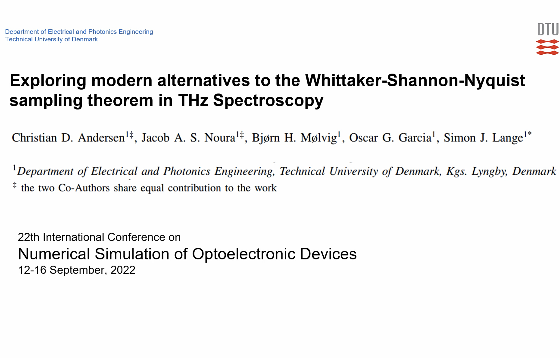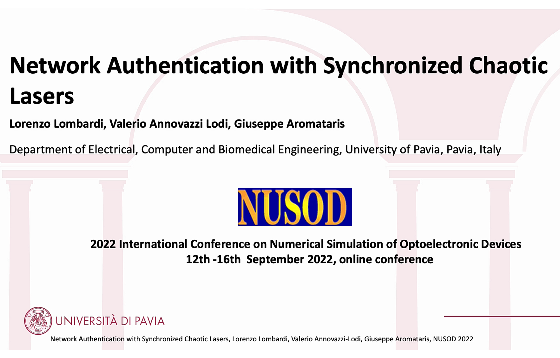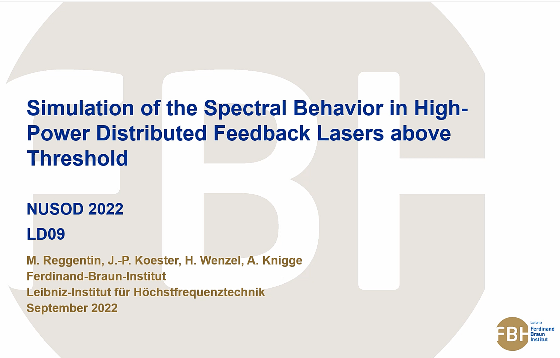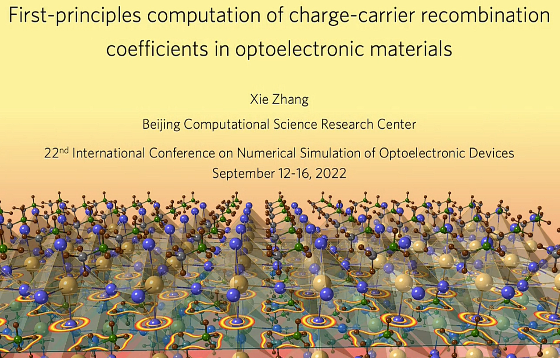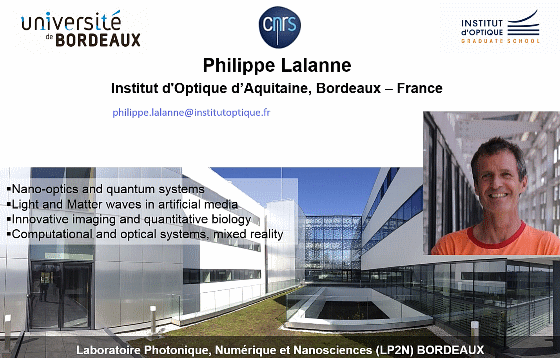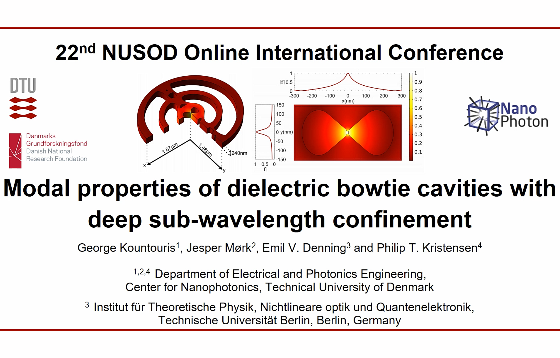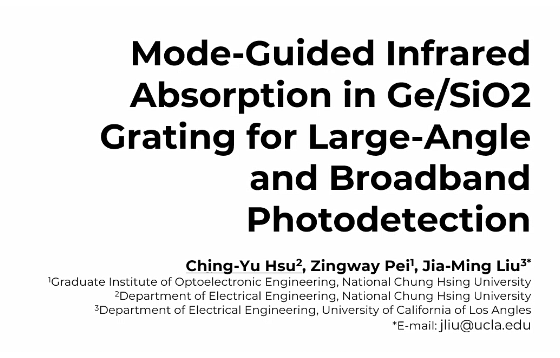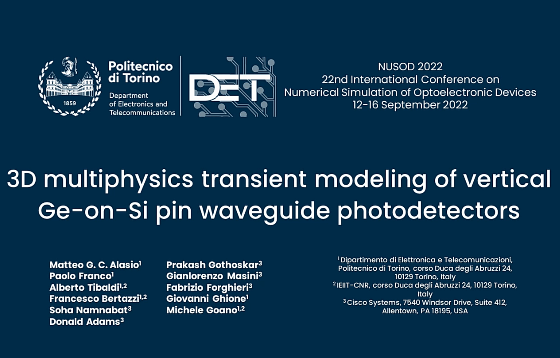Oral51 Videos



Non-Markovian noise degrades the coherence properties of semiconductor lasers and contributes significantly to broadening of the linewidth. Since modeling of such colored noise systems from first principles is not accessible, we aim for a data-driven modeling approach in which a system of stochastic rate equations shall be reconstructed from time series data.
NM06 – Modelling an Acousto-Optic Beam Shaping Device for a DIRCM Laser Laboratory Setup
Directed Infrared Counter Measure (DIRCM) laser laboratory setups are used to mimic the real life DIRCM system and IR heat-seeking missile engagement scenarios in isolated laboratory environments. Typically, the output beam of a mid-infrared (Mid-IR) laser source is modulated in time using an acousto-optic (AO) modulator (AOM). Following the AOM in the optical path, within […]
MM09 – FiPo FDTD: Computational Electrodynamics Technique Producing Both Fields and Potentials
We present the field–potential finite-difference time-domain (FiPo FDTD) algorithm, which solves a set of first-order equations for the electric and magnetic fields (E and H), as well as the magnetic vector potential A and the scalar electric potential φ in the Lorenz gauge. We also present the derivation and implementation of a convolutional perfectly matched […]
LD07 – Physics-based time-domain modeling of VCSELs
This paper presents the results of a physics-based time-domain simulator for a vertical-cavity surface-emitting laser (VCSEL). We implemented a trapezoidal rule second order backward differentiation formula (TR-BDF2) to simulate the large signal response of the device under investigation, including the parasitic effects of the pin junction arising from an interplay of optical and carrier transport […]
N02 – Influence of random alloy fluctuations on the electronic properties of axial In(x)Ga(1−x)N/GaN nanowire heterostructures
Compound semiconductor heterostructures such as quantum dots, nanowires, or thin films, are commonly subject to randomly fluctuating alloy compositions if they contain ternary and quaternary alloys. These effects are obviously of an atomistic nature and thus rarely considered in heterostructure designs that require simulations on a continuum level for theory-guided design or interpretation of observations. […]
P01 – Continuous-Wave Second-Harmonic Generation in Orientation-Patterned Gallium Phosphide Waveguides at Telecom Wavelengths
A new process to produce Orientation-Patterned Gallium Phosphide (OP-GaP) on GaAs with almost perfectly parallel domain boundaries is presented. Taking advantage of the chemical selectivity between phosphides and arsenides, OP-GaP is processed into suspended shallow-ridge waveguides. Efficient Second-Harmonic Generation from Telecom wavelengths is achieved in both Type-I and Type-II polarisation configurations. The highest observed conversion […]
LED05 – Reliable prediction of the singlet-triplet gap in TADF molecules with GW/BSE approach
Organic light emitting diode (OLED) molecules that exhibit thermally activated delayed fluorescence (TADF) have emerged as a promising technology for various lighting and display applications. Such systems depend on low singlet-triplet gaps of the order of kT to allow reverse inter-system crossing. Here, we demonstrate the capability of a GW/BSE method to predict excitation energies […]
NM01 – Machine Learning Assisted Material and Device Parameter Extraction From Measurements Of Thin Film Semiconductor Devices
The simulation of thin film semiconductor devices is challenging, partly due to the unknown material and device parameters. In this contribution, we present two different approaches to determine the missing material and device parameters from measurements. They both have in common that they are based on machine learning (ML) and numerical models. First, a numerical […]
MM07 – Volume exclusion effects in perovskite charge transport modeling
Due to its flexibility, perovskite materials are a promising candidate for many semiconductor devices. For example, Perovskite Solar Cells (PSCs) have become recently one of the fastest growing photovoltaic technologies. In this work, we take volume exclusion effects into account by formulating two different current densities – either treating the mobility or the diffusion as […]
LED02 – Carrier Transport in Multi Colour Deep Ultraviolet Light Emitting Diodes
Deep ultraviolet (DUV) light emitting diodes (LEDs) and lasers are enabled by high band gap Aluminium Gallium Nitride (AlGaN). The efficiency of recent multi quantum well (MQW) DUV emitters is still in the percent range which can be in part attributed to the hole injection. The hole injection and the carrier distribution in the high […]
NM03 – Simulation of Near-IR and Mid-IR Cascade Raman Microlasers Based on Bismuth-Modified Tungsten-Tellurite Glass
We theoretically investigate cascade Raman generation in bismuth-modified tungsten-tellurite glass microlasers, for the first time for microcavities based on TeO2 glasses. The calculated results demonstrate the opportunities of CW Raman generation in the near-IR and mid-IR ranges with CW pump at the wavelength of 1.55 μm. The predicted wavelengths are 1.81 µm, 2.17 µm, 2.70 […]
LD02 – Microscopic modeling of interface roughness scattering and application to the simulation of quantum cascade lasers
The theory of interface roughness (IFR) scattering in semiconductor heterostructures is well established in the case of idealized abrupt interfaces. However, in reality, interfaces have a finite width, i.e. interfaces are graded. In such case, the effect of interface roughness, i.e. the breaking of in-plane invariance, a general framework has been lacking to describe the […]
IS02 – Exploring modern alternatives to the Whittaker-Shannon-Nyquist sampling theorem in THz Spectroscopy
We present simulations for a THz cross-correlation spectroscopy (THz-CCS) optical system. The aim is using compressed sensing (CS) to reconstruct the THz signal from a random under sampling of the signal and potentially replacing a delay stage unit of the THz-CCS system to increase robustness and cost-effectiveness of the optical system. We present results from […]
IS01 – Network Authentication with Synchronized Chaotic Lasers
We numerically study a hardware method for network authentication, where a pair of matched (twins) chaotic lasers generate the same chaos when they synchronize, being subject to the same optical injection from a third chaotic laser. One of the lasers is in the secure environment, the other in the unsecure environment, and authorization is granted […]
LD09 – Simulation of the Spectral Behavior in High-Power Distributed Feedback Lasers above Threshold
We report on the simulations of mode hopping behavior in semiconductor distributed feedback lasers with asymmetric facet reflectivities above threshold and its dependence on the phase between the grating and the high reflective facet.
LED01 – First-principles computation of charge-carrier recombination coefficients in optoelectronic materials
Charge-carrier recombination plays a decisive role in determining the efficiency of optoelectronic materials and devices, but their accurate experimental measurements and interpretation are challenging. In this context, first-principles computation of charge-carrier recombination coefficients is particularly useful. It allows not only rigorous computation of the recombination rates, but also intuitive interpretation of the microscopic recombination mechanisms […]
MM01 – Rigorous modal analysis of micro or nanoresonators
The most general motion of a system is a superposition of its normal modes, or eigenstates. We report our recent developments of a rigorous modal analysis of electromagnetic resonators, which is accurate even for geometries that have not been analyzed so far, e.g. 3D resonators made of dispersive media and placed in non-homogeneous backgrounds (on […]
P02 – Modal properties of dielectric bowtie cavities with deep sub-wavelength confinement
We present a quasinormal mode analysis of a dielectric bowtie cavity with deep sub-wavelength confinement. The cavity – which is based on an inverse design by topology optimization – exhibits a remarkable sensitivity to local shape deformations, which we show to be well described by perturbation theory.
D05 – Mode-Guided Infrared Absorption in Ge/SiO2 Grating for Large-Angle and Broadband Photodetection
The numerical simulation of the electromagnetic properties of the Ge/SiO2 grating structure with bottom distributed Bragg reflector. With mode guiding in Ge, the structure exhibits an absorption angle of 100° and broadband behavior from 1300 to 1500 nm.
D03 – 3D multiphysics transient modeling of vertical Ge-on-Si pin waveguide photodetectors
We report transient simulations of Ge-on-Si vertical pin waveguide photodetectors (WPDs), where the optical generation term used by the time-domain model is the FDTD solution of the electromagnetic problem treated as a spatially-distributed pulsed signal. This approach, validated against experimental measurements of the frequency response, paves the way to future studies of the dynamic response […]

